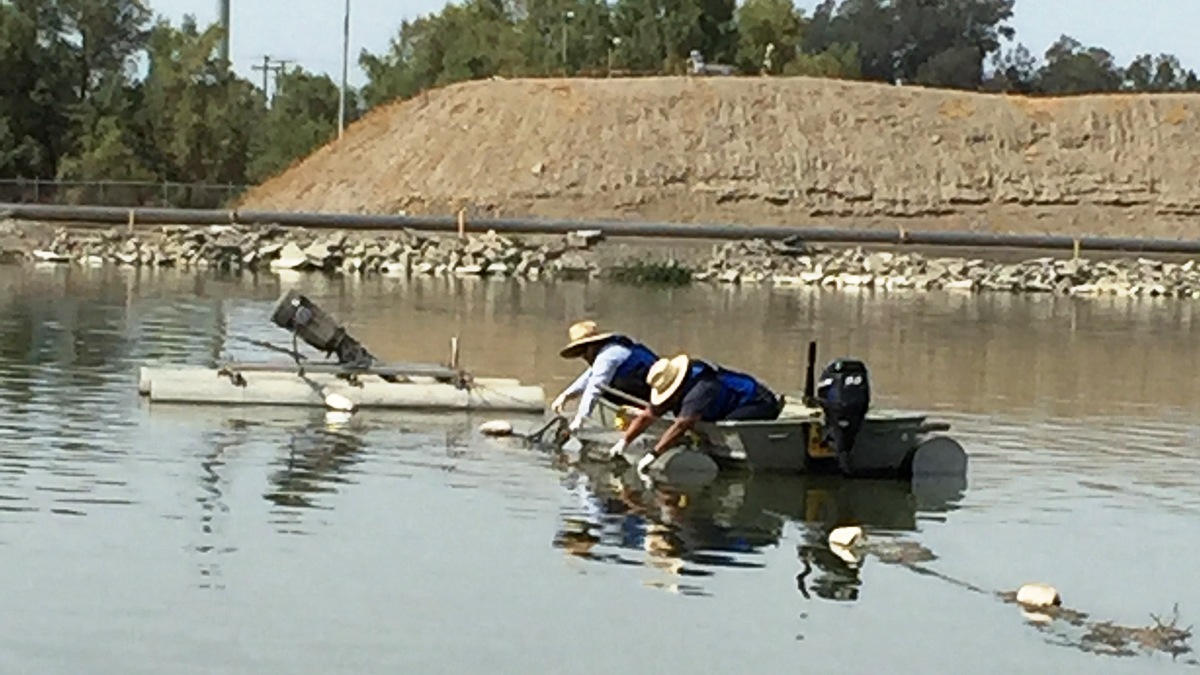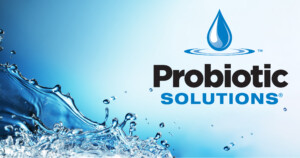
Wastewater treatment operators manually removing wipes from a lagoon
By Jael Batty
The fatberg discovered in Great Britain sewers has raised consumer awareness about disposable wipes blockages. But the 140-ton mass is just the tip of the wipes iceberg that is destroying our wastewater infrastructure. Similar fatbergs are clogging sewers in large cities around the world.
Fatbergs form when wipes, oil, and grease solidify in sewer lines to create a massive blockage.
Wipes can contain plastics
From personal hygiene to industrial cleaning, disposable wipes have a number of different uses. Wipes are made with nonwoven cotton or cellulose (wood pulp) fabric. Non-woven fabric is made by pressing a mass of loose fibers into a sheet then bonding them together with heat, chemicals, or by mechanical methods. Flushable wipes fabric is reinforced with fibers such as viscose (which is a semi-synthetic cellulose). Non-flushable wipes are strengthened with synthetic fibers such as polyester (which is a plastic). Since they are not actually biodegradable, the biological wastewater processes that digest organic matter are not sufficient to break down wipes, whether they are flushable or not.
The number of wipe obstructions is staggering
Consumers flush both flushable and non-flushable wipes. Worldwide, the number of reports of wipes blockages is staggering. The wastewater industry removes thousands of tons of wipes from sewer lines annually. Wipes that make it through our sewer lines block the screens at wastewater plants. Those that slip through the screens wind around pump shafts. They clog up sludge pumps and create issues in aeration basins and clarifiers. If they’re not removed at screening or at a clog, wipes that make it through the treatment process solidify in lagoons.
Wipes blockages cause issues outside sewer systems and wastewater treatment plants as well. The fact that wipes are washing up on beaches indicates that they ride out the treatment process all the way into the environment. Raw sewage from wipes blockages has flooded lakes and even a playground. Sewage backups caused by wipes damage homes and businesses.
Blockage removal is messy, dangerous, and costly
Not only do blockages and the related repairs stop wastewater treatment—sometimes for days—but removal is labor-intensive and dangerous. If wipes cannot be jetted out, municipalities must tear apart pipes to unstop wipes obstructions. Operators enter small spaces filled with biological waste and toxic fumes. They “de-rag” sewer pumps by hand on a weekly basis, if not more often. Divers swim into raw sewage to clear jams caused by wipes. Sometimes removal by hand or with hand-held tools isn’t enough. Removing massive clogs or fatbergs requires the use of heavy machinery.
Repairing the wipes obstructions and breakages costs the wastewater treatment industry billions of tax dollars. Billions that could be better spent repairing our aging wastewater infrastructure.
Industry standards don’t stand up to reality
The argument against flushable wipes is that the term is both relative and unregulated. If it breaks down over a period of time, it is biodegradable. If you can put it down the toilet, it is flushable. And consumers will flush items labeled “flushable.” The convenience of flushable wipes is so great that the industry is forecast to expand 5.1% annually.
Additionally, flushable wipes standards don’t pass water industry tests. Unfortunately, wipes standards are set by associations for the flushable wipes industry. Those standards are also voluntary. This means that wipes manufacturers may use a “flushable” or “biodegradable” label regardless of whether or not they’ve met industry regulations.
Along the same lines, wipes labeled as “septic safe” are not necessarily safe to use in septic systems. In fact, wipes contain chemicals that kill the beneficial bacteria that break down waste, which can result in costly repairs.
Blockages lead to lawsuits and legislation
The controversy surrounding “flushable” labeling and industry testing has led to multiple consumer and municipal lawsuits against flushable wipes companies. Additionally, legislation has been proposed to ban the flushable label. Regulations have even been put into motion against the sale of wipes altogether. But the flushable wipes industry is fighting litigations and restrictions—and winning.
Why? Because studies find that the majority of wipes removed from blockages are un-flushable. This means that the problem lies with consumer understanding. In fact, consumers are so confident of the flushability of disposable wipes that they don’t even check the label to see if they are flushable.
What can you do about it?
Wastewater treatment technology is evolving to deal with the wipes trend. Vortex impellers, chopper pumps, and grinders reduce wipes into small particles. These technologies are not a cure-all. They don’t remove wipes and they cannot always break down wipes sufficiently to avoid clogs. Additionally, shredding wipes puts them into the wastewater circulation, adding to microplastic pollution of our water supplies (which is a conversation for another day). Wastewater biostimulant products like Bio Energizer® help break down the oils and grease that hold wipes together.
While improvements in wastewater technologies are a reaction to the wipes issue, proactive steps are also being taken. In response to unsatisfactory standards and regulations, the international wastewater community is currently developing its own flushable standard.
In addition to developing regulations, the wastewater industry is turning to public service announcements, ads, and mailers to improve public awareness regarding flushing wipes, oil, and grease. However, convenience and an out-of-sight-out-of-mind mentality have a strong pull on consumers. Consumer patterns show that such campaigns must be persistent in order for consumer education to be effective long term.
Environmentally friendly alternatives to wipes include reusable cloth wipes, bidets, and moistening sprays for toilet paper.
Conclusion
Despite reports of obstructions, disposable wipes usage is increasing. Flushing those wipes, regardless of the label, causes serious problems for the wastewater industry. Fortunately, wipe regulations, consumer education, wipes alternatives, and improvements in wastewater technology are making small strides toward preventing another monstrous fatberg disaster.
How does your wastewater plant handle wipes blockages?
Related Posts

Rutgers Univ.: Huma Pro® Stimulates Root Growth
Huma Pro® Stimulates Rhizophagy Cycle of Microbes to Increase Root Growth, Rutgers Univ. Conducted by: James White, PhD, Rutgers University Huma Gro® Products: Huma Pro® OBJECTIVE The purpose of this research project was to evaluate how humic acids stimulate microbial activity and initiation of the rhizophagy cycle (in which plants cultivate microbes on their roots...

This Week in Ag #57
“What are you planting this year?” That may not sound like a trick question, considering it’s already mid-March. But ask any farmer south of the Mason-Dixon line that question and you’ll likely see their shoulders shrug. You see, unlike in the West, where permanent crops and processor contracts make planting decisions more straight-forward, or in the...

Water Master Plans
By Heather Jennings, PE When I worked with engineering firms, there were a lot of water master plans being developed. Many of them were updates, as the plans had been around for 5–10 years and needed revision. Some master plans evaluated water and wastewater systems from scratch. All of these were interesting to me due...

